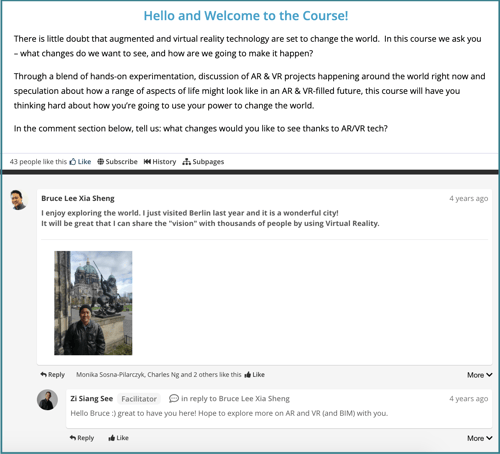When you’re designing your course, it may sometimes be easy to get caught up with questions like ‘how do I upload my slides?’ and ‘how do I enable learners to download the lecture videos?’. While this is important, it’s more important to keep the big question of ‘how do I design the experiences that I want my learners to go through as they complete the course and eventually achieve the course outcomes?’ in mind.
This question will encourage you to design learning experiences that not only enable your learners to achieve the course outcomes: active learning activities besides passively watching videos and/or listening to audio files.
Having an understanding of how people learn best is helpful when planning and designing meaningful learning experiences. Knowing the basics of what motivates your learners will be beneficial not only in the design of your course or learning sessions but it’ll also enable your learners to feel cared for and understood. When people feel cared for, they’re more likely to listen and learn. If you wish to increase the learning capabilities of your learners, tap into their intrinsic motivation.
There are several research papers explaining how people learn, from infancy to adulthood. While each stage has its nuances, it appears that all age groups can benefit from intrinsic motivation strategies. Consider the following to tap into your learners’ intrinsic motivation:
It’s necessary for every learning experience to have outcomes (e.g. “By the end of this course, learners will be able to…”). Outcomes are the reason why online learners enrol in courses, and they are a way to measure success.
However, it’s just as necessary, if not more, to be mindful of who the outcomes serve. If the outcomes are in place merely to satisfy the key performance indicator (KPI) of the course creator, then the learning experience will not bear much fruit. But if the outcomes are aligned to the needs of the learners, it is likely that your learners will put in the effort to achieve them.
Learners can be motivated by the chance to share their work, no matter how small. Creating a safe space for learners to show their work motivates them to continue learning. If the work that they produce is shared and discussed with other learners in the course, there is a high chance that learners are able to learn from the ‘better’ products of their peers and improve their own learning. The facilitator has to first create an inclusive and safe space for learners to feel confident in their work, and to see the space as one that’s collaborative as opposed to one that’s competitive.
Encourage learners to think about key takeaways from the learning experience and how they can implement what they’ve learned. Self-reflection prompts are helpful in getting learners to be mindful of their learning. These prompts can be as simple as (i) What is your main takeaway from this activity? and/or (ii) What will you do differently because of today’s activity?
Creating meaningful reflection spaces is important, so ensure that your learners are making connections between what they’re learning in your course and in their daily lives.
Constructivism is based on the idea that learners actively construct knowledge from experience, rather than passively taking in information. Constructivist learning experiences get learners involved in their learning as much as possible. This promotes a sense of ownership among the learners and increases their excitement to learn.
A few ways to involve your learners actively in the learning experience:
In a Constructivist learning environment, your role as a course creator is to carefully design experiences that will allow your learners to construct their own understanding and discovery of the subject matter.
If you’re unsure how to start, reflect on your own experience when learning about a subject. How did you start getting involved in the topic? At what point did the topic become interesting to you? What did you have to do to become an expert in the topic? Chances are, your learners will also need to go through a similar process.
Inquiry-based learning is when you get your learners to start the course with a challenge or a problem to solve. Your role is to support, guide, and mentor them in the process of discovering the solution.
For example, in the course below, learners were asked to think of a topic or challenge that they want to explore. In this case, they were asked about the changes they want to see in the world, thanks to advancements in AR/VR technology:

Throughout the course, learners were introduced to the fundamentals of AR/VR and all the different tools available in AR/VR projects. They were intrinsically motivated to learn about AR/VR by using the knowledge gained to achieve their own personal goal.
Understanding your learners’ motivation is a hidden gem especially for online course creators! If you can hook them by tapping into their intrinsic motivation, your job is much easier because they want to learn.
Remember that great learning design is the result of a creative process. As with any creative process, it requires some amount of thought and evolution of ideas.
So, consider starting with the basics and removing preconceived notions you might have about how “normal” online courses look or how teaching “should” be—and start thinking about how to create the best experience for your learners.
As a Learning Designer myself, this is what I have always strived for. Join me and the rest of the Learning Designers as we explore ways to achieve the best online learning experiences together via our programmes and resources below:
Featured image by EKATERINA BOLOVTSOVA from Pexels.
OpenLearning is an online learning platform with a focus on student empowerment, active learning, and community. Get more strategies to create engaging online courses at our latest event:
